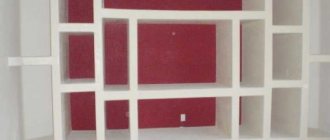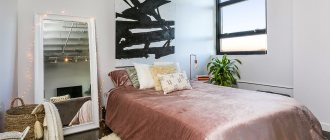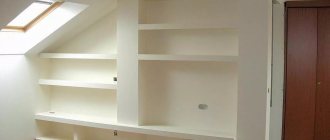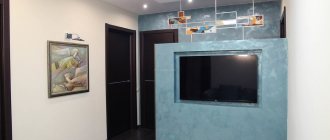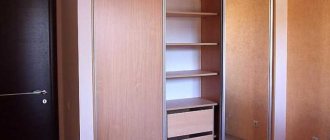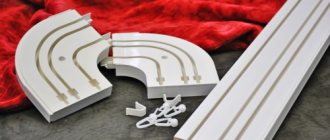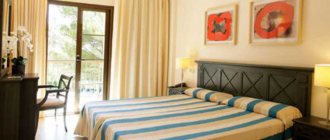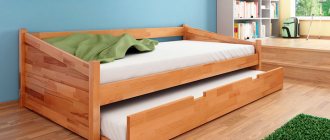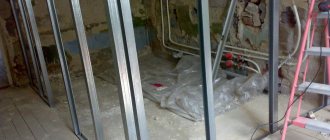Light in the niche
Of course, the light in the niche will give the sleeping area even more comfort. Think about what function it will serve. If you like to read before bed, then keep in mind that the lighting should be bright enough and at the same time pleasant to the eyes. Also, light can be purely decorative. You can make it colorful: use LED strip for this.
It can be placed in a recess above the bed or along the perimeter of the ceiling. The lighting inside the shelves will also look harmonious. It can also be colored. When choosing lighting, do not forget that it is better to choose warm light for the bedroom. Please note that you will see it every evening before going to bed and turn it on if necessary at night.
Now let’s try to figure out what is needed to make a plasterboard niche in the bedroom.
How to create a niche in the bedroom using plasterboard
If you want to give the interior of the bedroom individual characteristics, create a unique design with a niche, you can use plasterboard. With its help, excellent results are obtained with minimal money and time. Drywall gives the bedroom owner complete freedom of imagination when decorating the ceiling and walls.
A unique design solution for decorating a plasterboard niche
The advantages of using drywall when creating a niche are:
- Relatively low price.
- Installation is carried out without any particular difficulties.
- The material is convenient to transport.
To create a niche you will need:
- Metal profile elements.
- Drywall.
- Grinder or metal scissors.
- Electric drill.
- Screwdriver or screwdriver.
- Self-tapping screws.
- Pencil.
- Roulette.
- Plumb.
- Reinforcing tape.
- Glue.
- Putty and spatula.
- Construction level.
Tip: When making a niche from gypsum plasterboard, you can eliminate all unevenness, especially in apartments of panel houses, and in small rooms you can get a visual expansion of space. In addition, the bedrooms will become more comfortable and different from standard rooms.
The instructions for creating a niche with your own hands from plasterboard are as follows:
- The place where the niche will be installed is selected.
- The shape and dimensions are thought out.
- The necessary measurements are taken.
Tip: When determining the size of a niche, it is necessary to take into account the thickness of the sheets and the width of the rolled metal.
- A sketch of the device is being made.
- The drawing is transferred to the wall.
- Places for attaching the frame are marked.
- The frame is being assembled.
Advice: When purchasing drywall, you need to take into account unexpected breaks in the sheets and unevenness when cutting profiles, which requires a certain supply of material.
- The depth of the niche is measured from the wall, 13 millimeters of sheet thickness is added to this dimension and a line is marked for fixing the profile.
- Using a plumb line, the resulting marking is transferred to the ceiling.
- The wall frame is assembled from gypsum plasterboard. In this case, you need to ensure that the fastening of the guides is strictly along the marked lines.
- Profile blanks are cut to the required length.
- These elements are fixed to the vertical frame posts with self-tapping screws. In this case, the vertical segments must be placed opposite the horizontal ones to secure them.
Niche frame for fastening drywall
- The vertical elements are connected by jumpers.
- Sheathing the gypsum board frame. In this case, the assembly order is as follows:
- side walls are attached;
- all others are recorded;
- Reinforcing tape is fixed at the joints.
- Putty is applied in two layers. A sickle mesh is laid between them.
- The final decoration of the plasterboard niche in the bedroom is being carried out.
The process of creating a niche is shown in more detail in the video in this article.
After assembling the structure, it is finished with materials that the owner prefers. They may be:
- Decorative plaster.
- Dye.
- Mirrors.
- Wallpaper.
- Facing stone.
- Combined materials can be used.
The choice of finish depends on the load that the device will experience.
Ways to design a niche
Designers offer two ways:
- Contrasting color.
- A shade close to the interior of the room.
Tip: Do not paint niches with dark colors, the device will look like a “black hole”.
It is better to use bright colors or calm pastel shades for decoration. It is also necessary to pay attention to the shape of the niche:
- For rooms where low and long furniture is installed: a horizontal bed or bedside table is suitable. In addition, such a niche can visually lengthen a short wall.
- A vertical niche looks good near a window, door, bulky chest of drawers or closet.
Functional potential
Decorating a niche in the bedroom does not take much time, but in practice such an attribute fully justifies its presence and plays an important role in the interior. The simplest option involves placing furniture or equipment in an alcove. For example, a niche above the bed can serve as storage for a canopy, making the sleeping area cozy, secluded, and intimate.
The design for a TV allows, if necessary, to “hide” equipment in those interior compositions where all kinds of technical devices come into aesthetic dissonance with other elements. We are talking about all rustic styles (country, Provence, expensive classical styles (Rococo, Baroque), design with eco-trends.
In any case, a plasterboard niche can solve a number of particularly important problems:
- Eliminate all kinds of defects and irregularities in a specific area;
- A good, thoughtful design of a bedroom with a niche will significantly expand the space of even the smallest boudoir;
- Create unusual storage for various household items.
It should be remembered that drywall itself is not strong enough to support significant weight. If the composition of shelves and closed cells is quite solid and takes up a lot of space in height and width, the plasterboard elements are supplemented with a frame made of profiles. Reinforcement of the structure with stiffening ribs is encouraged.
What types of niches are there for the bedroom?
The device is a recess in the wall. There are two types of niche:
- Deep. This recess is made according to the size of the bed, as can be seen in the photo. If there is a double bed, it is placed at a right angle to the wall, and a child’s bed and a single bed are placed along the wall.
Such recesses look very elegant, looking like small caves. Here you can create a secluded, quiet place where you can retire with your favorite book or drink a cup of milk or cocoa before bed.
Inside the niche on the sides you can make several rows of shelves (see Shelf in the bedroom: which is better), and arrange drawers underneath for storing linen, clothes, shoes, which is quite important for small-sized apartments. In the nursery, books and the child’s favorite toys can be placed on such shelves.
When combining a bedroom with a living room, the niche can be curtained with beautiful curtains or doors, which will hide the bed and the rest of the space from prying eyes. How a bedroom with a niche for a bed is designed depends only on the wishes and tastes of its owners.
Bed niche in the bedroom
- Shallow. As a rule, this type of recess is used for decorative purposes. In this case, it is done behind the headboard of the bed. Small shelves are placed here; behind the back you can stick photo wallpaper, install a colored mirror or hang a picture.
Shallow niche in the bedroom with shelves
All the advantages of plasterboard niches in the bedroom
A niche made of plasterboard can serve as a bedside table or even a cabinet; it can accommodate your entire library or remain an effective interior decoration without much practical use.
To create it, you are free to choose lush or laconic forms, change the volume as you like, but the main advantages of plasterboard construction will remain:
The walls in the niche can be covered with wallpaper
- Budget - drywall is relatively cheap.
- Speed of installation - to create a complex-shaped niche on the entire wall, you will need no more than 2 days.
- Environmental friendliness. Plasterboard sheets are made from safe components, and therefore can be used in living rooms without restrictions.
- Effectiveness. A niche created taking into account the proportions of the room will look amazing.
- The ability to expand a static space, fill it with volume, change the boundaries of the room.
Recommendation. The plasterboard niche is designed in accordance with the overall interior concept of the bedroom. This means that you don’t have to select additional shelves or frames taking into account the non-standard shade of the furniture façade. Beauty, modernity and expressiveness - these are the main advantages of plasterboard niches.
↑ back to contents
